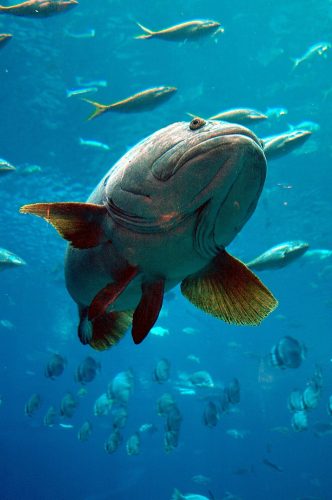The maximum recorded weight of a goliath grouper is 800 pounds. In Florida, the record is 680 pounds, which was the weight of a grouper caught at Fernandina Beach way back in 1961. If you are curious about the comparison, you can try swimming with them in Palm Beach, Florida. Goliath groupers are definitely not your ordinary-sized fish because they can grow up to as much as eight feet long! This means a fully grown grouper can be fairly taller than a human being. It is not that easy to catch a fully grown one, which is why you will mostly see photos of ones within the range of four to six feet.
They are quite friendly to humans. In fact, these fish are so docile that usually, you can just slowly swim up to them and pet them. All they will do is hover motionless, facing the current. Sometimes they readily approach divers, too, allowing them to remove hooks and fishing lines. The mammoth size of goliath groupers causes them to make extremely loud underwater sounds as well. As you might know, many species of fish tend to use their swim bladders to produce sound. It’s the same for goliaths, too, except the sound they end up making is so impactful that divers who have heard it often describe it as a “sonic boom”.
They produce this sound when they are spawning and sometimes when scuba divers approach them. According to Laurent Chérubin, associate research professor of Harbor Branch, the sound tends to be of a rather low frequency, around 60 Hertz. This is actually 40 Hertz louder than the bottom of human’s audibility range, whereas the sound made by most other fish is way below it.
The Atlantic Goliath Grouper, scientifically known as Epinephelus itajara, is a saltwater fish of the grouper family famous for its gigantic size. It was formerly called Jewfish. Usually observed in Florida waters, these fish are solitary, sedentary, and territorial.
It is one of the largest species of bony fish out there, and its size will truly shock you. In this article, you can find a more detailed discussion about how big a grouper can get, their habitat, diet, and whether you can eat them.

Where Are Goliath Groupers Found?
The main habitat of goliath groupers is in the waters of Florida. According to the Florida Fish and Wildlife Conservation Commission (FWC), the Ten Thousand Islands area off Southwest Florida seems to be the center of abundance for these gentle giants. In the first five to six years of their lives, groupers tend to swim around this mangrove location, before moving on to the shallow reefs as they grow.
Eventually, the groupers end up with the rest of the adult population offshore on the shallow artificial as well as natural reefs. Interestingly enough, though the youngsters prefer mangroves, adults feel more comfortable hanging around in places with bridges, overhangs, piers, and shipwrecks. But the mangrove waters are still considered as a critical nursery habitat for them.
Goliath groupers’ natural habitat spreads far across the west. Beyond northeast Florida, they are available in the south throughout the Gulf of Mexico, the Caribbean Sea, as well as along the waterway of South America to Brazil. They’re even in the east, swimming in the West African waters of Senegal to Cabinda. They are usually observed at a depth ranging from three to 328 feet or one to a hundred meters.
What Do Goliath Groupers Eat?
The diet of a fish definitely has an impact on the size they end up becoming. Goliath groupers are actually opportunistic predators who like to prey on the slow-moving species of fish who stick to the bottom. They ambush the prey, catching them by rapidly expanding the mouth, sucking them in, and then swallowing them.
Researchers who have examined the stomachs of groupers have found its contents to be mainly composed of crabs. Calico crabs are the main part of their diet and constitute the majority of it. Aside from these, they also eat different bottom-dwelling spiny fish and invertebrate species, as was revealed in a report of FWC.
Recreational anglers often blame goliath groupers for taking away their catches like snook, snappers, and lobsters. But no research has yet found those to be a part of their diet as well. This is mainly because they will not usually go for speedy free-swimming fish as they are not that fast themselves.
But their large size acts as an advantage for sure. On July 12, 2018, a grouper fish of 500 pounds weight was found to eat a 3 feet long shark in Everglades City, as captured by Captain Jimmy Wheeler from the Everglades Fishing Company. They do not typically attack humans but are still pretty terrifying and unpredictable to be around.
Despite their large size, they can still become prey instead of predators. Before they reach their full size, they are often preyed upon by king mackerels, moray eels, and barracudas. Sandbars and hammerhead sharks will also go for them once in a while, but after they are fully grown, large sharks and humans are their only predators.
Can You Eat Goliath Groupers?
Such a large fish can easily aid a family for a whole month, so you might be wondering if goliath groupers can work as food. Actually, you will find them in the seafood menus of countries like Cuba. It is said that the older they grow, the tougher their meat becomes. However, just because they are on the menu doesn’t necessarily mean you should eat them.
The main reason is that the muscles of goliath groupers hold a high concentration of a chemical called methylmercury. This chemical can pose severe health risks for humans. Most people who eat them either don’t know about this or like to play with fire. One of the common side effects is erectile dysfunction.
Aside from reproductive health, mercury can also affect body systems, including the renal, immune, cardiovascular, digestive, and neurological systems. This information was published in the Journal of Preventive Medicine and Public Health in a 2004 article named “Environmental Mercury and Its Toxic Effects.”
According to Sarah Frias-Torres, a marine researcher who has worked extensively on goliath groupers off the Treasure Coast and Palm Beaches, killing these gentle giants isn’t worth it. Nature has made it pretty obvious that they are not meant to be eaten by humans. Well, these gentle giants are definitely a sight to see. There is not much point in killing them, and instead, it’s better to preserve them and let them stay home. And if you are in Florida, maybe you can play with them once in a while too!










Pingback: Where Are Groupers Native To? | Reel Fishing Guru
Pingback: Nassau Grouper: What are they and Where do they Live? | Reel Fishing Guru
Pingback: Differences Between Grouper and Halibut | Reel Fishing Guru
Pingback: Differences Between a Catfish Rod and a Grouper Rod | Reel Fishing Guru
Pingback: How Does Wreckfish Compare to Grouper? | Reel Fishing Guru
Pingback: Do Groupers Attack Humans? | Reel Fishing Guru
Pingback: What is the Difference Between a Grouper and a Shark? | Reel Fishing Guru
Pingback: What Is the Difference Between a Grouper and Haddock? | Reel Fishing Guru
Pingback: Why Are Groupers Protected? | Reel Fishing Guru
Pingback: What Is the Difference Between Grouper and Bream? | Reel Fishing Guru
Pingback: What Is the Difference Between Grouper and Skate? | Reel Fishing Guru
Pingback: What Is the Difference Between Grouper and Red Snapper? | Reel Fishing Guru